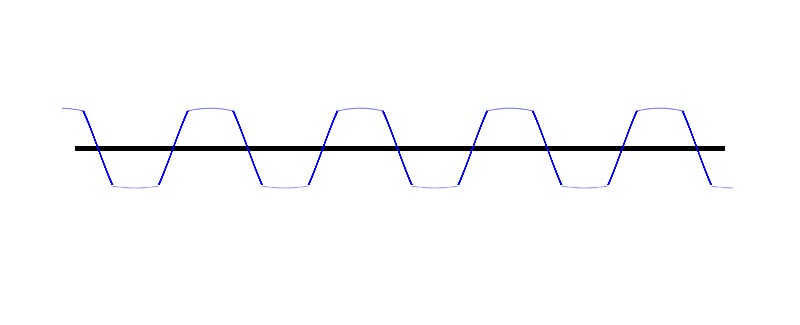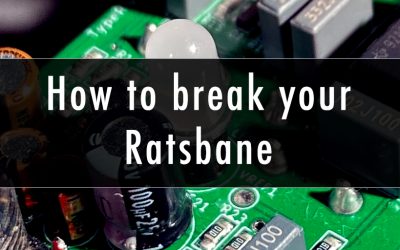
… I’m on a learning curve, so we might as well carry on! As I said in my previous idiot’s guide, that name firmly applies to me, so I’m researching subjects that I don’t know about, but as someone who has been playing for years should, and posting my findings in this blog. Hope that in reading this you will find it as interesting as I did when I was researching it. I’m going to use some visual metaphors in here that doesn’t make much sense, but they have helped me understand what is happening much better.
What causes overdrive, distortion, gain? Well, the first thing we HAVE to get out the way is that those are actually buzzwords that don’t really mean anything other than a term we use to consolidate it in our heads, the true word to use in this is CLIPPING.
What?
Yes, clipping. Overdrive, distortion, fuzz, etc. comes from ‘clipping the signal’. But what does that actually mean? Clipping occurs, in real terms, when the audio signal amplitude exceeds the maximum voltage capability of the system it is in. Or, in real terms, when the wave is trying to get through a hole that it’s too big for. Does that make sense? A true sound wave, a pure one, is a sound wave that is a classic sine – fully up and down movement moving at a certain speed. It is the way this wave moves that gives sound character, so if you listen to this – this is about as pure as it gets I suppose, this is a note produced by vibrating the signal at 440 times a second, or to name it, ‘Hertz’ (let’s not go to the 432hz thing, I might come to that in a later piece).
So, when this signal is pure and it’s vibrating in an unrestricted way, you get a ‘clean tone’ (I’m not going to get into how different amps and guitars effect that tone, as this is a scratching of the surface piece). In order to distort the signal, or overdrive it – or force it through the hole that it’s too big for, we ‘clip’ it. We take the top off, take the bottom off, usually take them both off. Gain is a misnomer, increasing gain actually means increasing volume within a circuit, but after it’s been messed with, it increases clipping.
So, here is a basic ‘clean tone’ sine wave.

When we clip that signal, it will look something like this…

This occurs by amplifying the signal a lot and placing a limit on the wave, so it gets ‘clipped off’ before it hits its natural peak/trough and comes back round again, the demonstration above would probably be more in line with soft clipping, as the amplification isn’t too great and the wave is pretty well intact apart from the extremities.
We get more severe levels of clipping, by increasing the initial amplification and making the clip more angular. Like this…

I fully expect that the more scientific/mathematical among you are looking at those and thinking “That’s not right, it needs to be more etc. etc.” but I’m not a scientist or a mathematician, I’m just a guy who knows his way around photoshop and this is the easiest way to show it.
One thing we have to remember here is that clipping is not the same as compression of limiting. We are not clipping the top and bottom of the wave with compression and limiting, we are just reducing the depth of the wave and bringing it more in line with the other waves, so the dynamics will be reduced but the shape of the wave will be retained.
The real joy of clipping comes with, as you may expect, adding in EQ (putting it before or after the clipping), low or high pass filters, or making the clipping asymmetrical and the millions of other things you can do to it… If you think about the classic OD circuits and how they change the tone as well as clip it, you start to teeter closer to the edge of the rabbit hole that is designing effects pedals.
The main thing that surprised me when I started to learn about clipping the signal is that it’s not how you would expect, as when you get to different reactions and requirements, you request the signal be clipped in different ways. For example, the classic ‘tube overdrive pedal’ works best when hitting an already clipping amp, the process aligns up and the result is truly glorious. For this reason, our Clarksdale – with the inherent EQ hump – will just accentuate what is already happening – with soft clipping. A distortion pedal, like the Dracarys, is treating the process completely differently – mostly hard clipping – needs a cleaner platform to work.
As a final point, analog clipping is fantastic, digital clipping currently is just plain awful… however, alot digital overdrive/distortion will replicate the characteristics and traits of analog clipping so progress is there and it’s coming…



@brian – wonder if you could make a video showing how to take a dirt pedal and an EQ pedal and make them sound like a different pedal..like ts-style+EQ =tumnus, or tumnus +EQ =Dumble-style or tumnus+EQ to sound like a ts-9…if that makes sense.
I like it!
Digital everything is awful . The holy Grail being a Dumble I wonder if any of these Dumble type pedals actually come close ? Without pushing it into a Princeton or studio type amp , but something more akin to a crate . 💪 you already made the best Klone .Are you ready to Dumble?
Thanks for explaining how overdrives works, a week ago I bought (in the German Thomann online store) Tumnus Deluxe, it’s great! …. I am from Eastern Europe from Prague. And I often watch your videos on youtube.
Glad yo like the videos dude!
Thanks for this. The sound engineer at the church where I play bass complained that my effects pedal was clipping, and I had no idea what he meant by it. Seems that the box was doing exactly what it was designed to do!
Hello. I just wanna ask. I have a Wampler Plexi Drive. The pure white. When I use my 335 and PRS on it, it sounds like it’s peaking. Like a wavy kind of sound. Pick ups are overwound humbuckers. It doesn’t do that with my Tele. I have a Timmy infront of it. Thanks in advance for the reply!
Hmmm – You could try lowering your pickups slightly and seeing if that helps? Let me know if it does
Which of your ODs have asymmetrical clipping?
Hey Brian,
In a circuit such as the Pantheon where you are doing both soft and hard clipping at the same time… what is being clipped in that scenario? are the just clipping at a different threshold?
thank you!